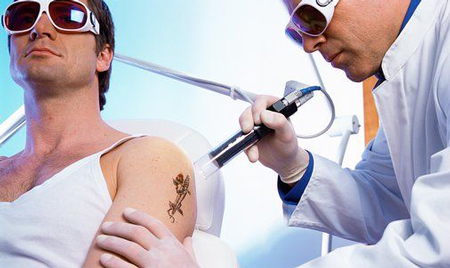
In later years the tattoo may not seem to have been such a good idea. A tattoo that “made a statement” in one’s youth can be an embarrassment as one matures, becomes employed, gets married, etc.
Dermatologists can offer a number of methods of tattoo removal. The choice of method depends on such factors as (1) the location of the tattoo on the face or body, (2) the depth of tattoo pigment in the skin and the extent to which it has migrated from the site of deposition, (3) the cost of the procedure, and (4) the outcome desired by the patient.
Professionally applied tattoos are usually easier to remove than those done by an amateur because the tattoo pigment tends to be more evenly distributed under the skin. Tattoos by amateurs are frequently done by depositing India ink under the skin with a needle, at varying depths under the skin and at varying concentrations. Black and blue tattoos are the easiest to remove; green and yellow are the hardest.
The older the tattoo, the more likely it is that pigment will have migrated widely and deeply under the skin. Thus, some “old” tattoos may not be completely removable by any means other than wide and deep surgical excision. If surgery is agreed upon as the best treatment, patient and physician should discuss the probable extent of the surgical scar and how the scar can be minimized.
Other methods of tattoo removal include:
Salabrasion—Salt is used as an abrasive to peel away the tattoo surface and underlying layers. Several salabrasion treatments may be required. The salabrasion procedure can cause substantial discomfort for some patients and it cannot remove pigment in deeper layers of skin. Local anesthetic is administered to minimize discomfort. Healing requires several days.
Dermabrasion—A rapidly rotating brush is used to remove pigmented skin. Dermabrasion can often remove all pigment in a professionally-applied tattoo, but if pigment has migrated or been deposited in deep subcutaneous fat, complete removal by dermabrasion may not be possible. Surgical excision is the only way to remove all pigment when subcutaneous fat is involved. Local anesthetic is usually administered to minimize discomfort. Healing may require several days.
Chemical Peeling – Application of this acid to the skin can remove tattoos in a cost-effective method but may leave a small scar. Consult with your dermatologist to determine the best result in partial or total treatment with peeling agents.
Laser removal—Removal of tattoo pigment can be done with infrared lasers or color-specific lasers. Color-specific lasers such as the Q-switched ruby laser and alexandrite laser, and the infrared Nd:YAG and carbon dioxide lasers, have proven very effective in removing tattoos. Multiple treatments are usually necessary, especially when tattoos are multi-colored. Black tattoo pigment absorbs all laser wavelengths, making it the easiest to treat. Other colors, such as green, selectively absorb laser light. These colors can only be treated by selected lasers based upon the pigment color. Similar to dermabrasion, results are influenced by the depth of pigment in the skin and other factors. Local anesthesia is usually given to minimize discomfort. The treated area is a burn that heals over a number of days. Infrared lasers such as carbon dioxide (CO2) and Nd:YAG are especially effective in removing large, superficial tattoos with minimal subsequent scarring. The powerful infrared laser beam can vaporize and remove pigmented tissue.
Color-specific lasers remove tattoos by color-specific absorption of laser energy by pigments in the tattoo. Destruction is limited to pigments of the same color (wavelength) of the laser beam, and at tissue depths were the laser beam can penetrate. It may be necessary to use several color-specific laser beams over several subsequent treatments to remove pigment from a multi-colored tattoo. Q-switching technology that delivers short, powerful laser pulses has improved the effectiveness of color-specific lasers in tattoo removal.
The most common complications of tattoo removal are scarring, and residual pigment under the skin. It is helpful for a patient to know that tattoo removal almost always results in a scar of some kind. The patient and dermatologist should discuss the probability of scarring, and post-procedure treatment for scarring. In some instances a choice must be made between a more extensive procedure to remove all pigment, and a less extensive procedure that may leave pigment in deep tissues.
